Developer Guide
- Acknowledgements
- GitHub Actions - for providing the Java CI badge
- Setting up, getting started
- Design
- Implementation
- Documentation, logging, testing, configuration, dev-ops
- Appendix: Requirements
- Appendix: Instructions for manual testing
- Searching and Filtering
- Data Handling
- Edge Cases
- Appendix: Effort
-
Appendix: Planned Enhancements
- 1. Disallow adding past appointment dates
- 2. Make the medicine field more structured and repeatable
- 3. Improve input validation and matching for name-based search
- 4. Allow appointment date to be cleared using the edit command
- 5. Add find-and-replace functionality for editing tags
- 6. Warn users about overlapping appointments
- 7. Fix highlight issue in multi-word name searches
- 8. Enable multi-name search to match across multiple patients
- 9. Improve robustness of flag handling
Acknowledgements
We would like to humbly acknowledge the following for the success of our project:
- The SE-EDU team for creating and maintaining the AddressBook-Level3 project.
- Our course instructors and teaching assistants whose patient guidance and feedback were instrumental throughout the development journey.
- Our peers and collaborators for their support, constructive code reviews, and insightful discussions.
- The open-source Java and JavaFX communities for providing comprehensive documentation and development tools.
- The developers and maintainers of essential libraries and frameworks used in this project, including Jackson for JSON processing and JUnit for testing.
Java Dependencies
- JavaFX - for Graphical User Interface (GUI) rendering
- Jackson - for JSON serialization and deserialization
- JUnit 5 - for JUnit testing
- JaCoCo - for generating test coverage reports
- Gradle Shadow Plugin - for creating executable JAR files with dependencies
- Checkstyle - for enforcing coding standards
Documentation Tools
- Jeckyll - for authoring and building the project website
- PlantUML - for creating UML diagrams used in the Development Guide
Badges
- CodeCov - for providing code coverage badge
-
GitHub Actions - for providing the Java CI badge
Setting up, getting started
Refer to the guide Setting up and getting started.
Design
.puml files used to create diagrams in this document docs/diagrams folder. Refer to the PlantUML Tutorial at se-edu/guides to learn how to create and edit diagrams.
Architecture
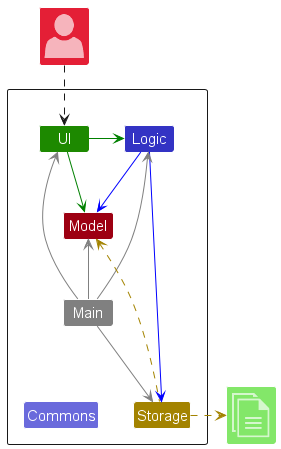
The Architecture Diagram given above explains the high-level design of the App.
Given below is a quick overview of main components and how they interact with each other.
Main components of the architecture
Main (consisting of classes Main and MainApp) is in charge of the app launch and shut down.
- At app launch, it initializes the other components in the correct sequence, and connects them up with each other.
- At shut down, it shuts down the other components and invokes cleanup methods where necessary.
The bulk of the app’s work is done by the following four components:
-
UI: The UI of the App. -
Logic: The command executor. -
Model: Holds the data of the App in memory. -
Storage: Reads data from, and writes data to, the hard disk.
Commons represents a collection of classes used by multiple other components.
How the architecture components interact with each other
The Sequence Diagram below shows how the components interact with each other for the scenario where the user issues the command delete 1.
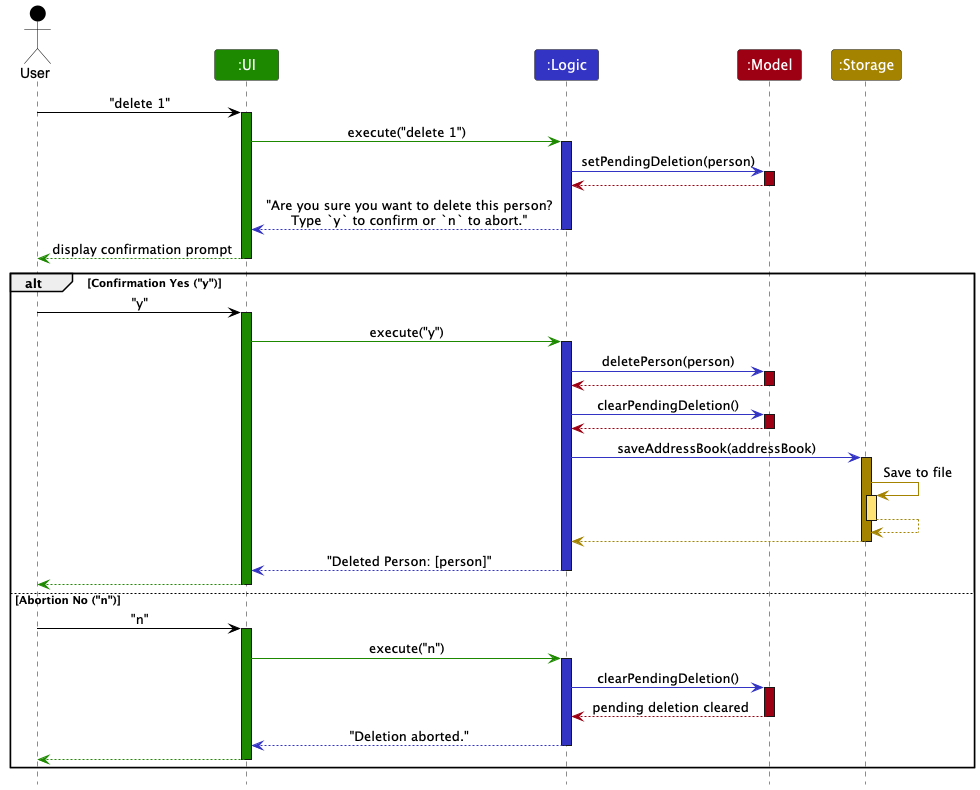
Each of the four main components (also shown in the diagram above),
- defines its API in an
interfacewith the same name as the Component. - implements its functionality using a concrete
{Component Name}Managerclass (which follows the corresponding APIinterfacementioned in the previous point.
For example, the Logic component defines its API in the Logic.java interface and implements its functionality using the LogicManager.java class which follows the Logic interface. Other components interact with a given component through its interface rather than the concrete class (reason: to prevent outside component’s being coupled to the implementation of a component), as illustrated in the (partial) class diagram below.
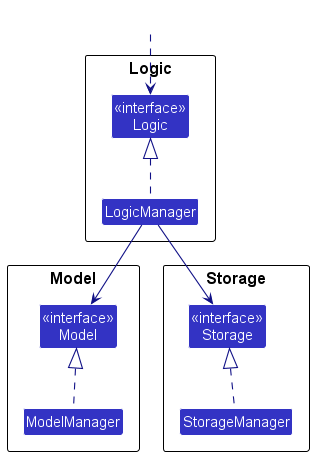
The sections below give more details of each component.
UI component
The API of this component is specified in Ui.java
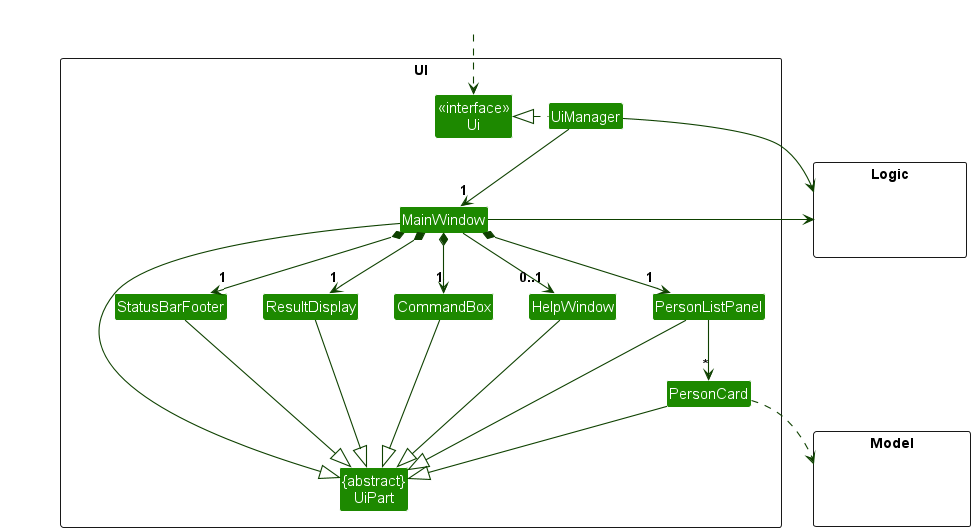
The UI consists of a MainWindow that is made up of parts e.g.CommandBox, ResultDisplay, PersonListPanel, StatusBarFooter etc. All these, including the MainWindow, inherit from the abstract UiPart class which captures the commonalities between classes that represent parts of the visible GUI.
The UI component uses the JavaFx UI framework. The layout of these UI parts are defined in matching .fxml files that are in the src/main/resources/view folder. For example, the layout of the MainWindow is specified in MainWindow.fxml
The UI component,
- executes user commands using the
Logiccomponent. - listens for changes to
Modeldata so that the UI can be updated with the modified data. - keeps a reference to the
Logiccomponent, because theUIrelies on theLogicto execute commands. - depends on some classes in the
Modelcomponent, as it displaysPersonobject residing in theModel.
Logic component
API : Logic.java
Here’s a (partial) class diagram of the Logic component:
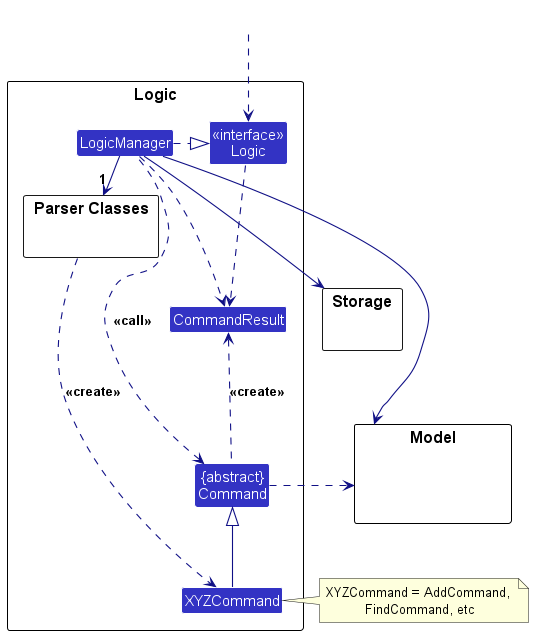
The sequence diagram below illustrates the interactions within the Logic component, taking execution of delete command API call as an example.
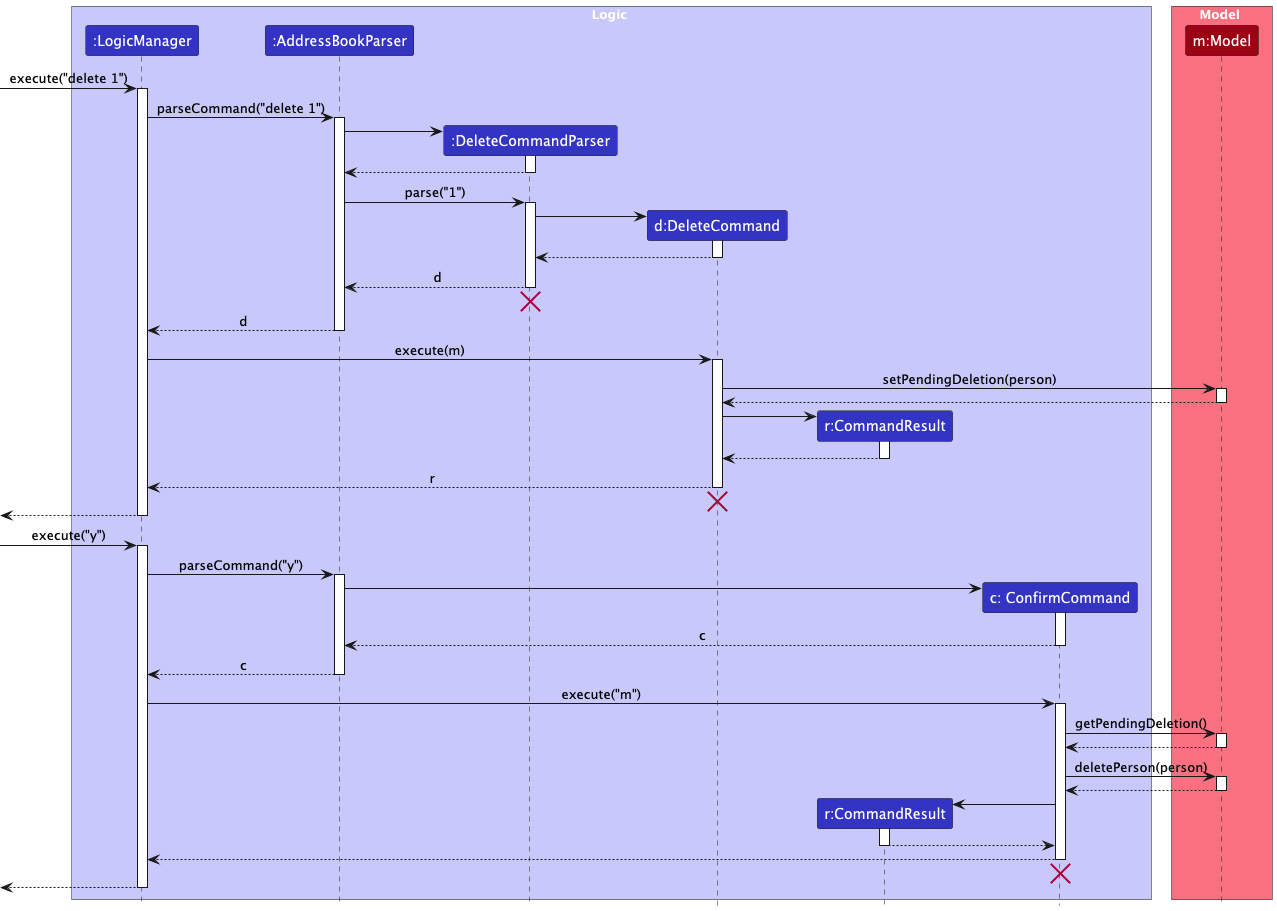
DeleteCommandParser should end at the destroy marker (X) but due to a limitation of PlantUML, the lifeline continues till the end of diagram.
How the Logic component works:
-
When
LogicManageris called upon to execute a command (e.g.delete 1), it passes the input to theAddressBookParser. -
The
AddressBookParseridentifies the command and, if necessary, creates a specific parser (e.g.DeleteCommandParser) to parse the input. -
This results in a
Commandobject (e.g. aDeleteCommand) which is returned and then executed byLogicManager. -
The command interacts with the
Modelduring execution — for example, it may callsetPendingDeletion(person)to store the target person while waiting for user confirmation. -
The result of this execution is wrapped in a
CommandResultobject, which is returned fromLogic.
-
When the user types
yto confirm, the input is passed again toLogicManager, which treats it as a new command. - The
AddressBookParserparses this as a confirmation and directly returns aConfirmCommand.📌 Note:
AddressBookParserdoes not create a specific parser for confirm commands, as they are simple and handled directly. -
LogicManagerexecutes theConfirmCommand, which:- Retrieves the person marked for deletion via
getPendingDeletion() - Performs the deletion using
deletePerson(person)
- Retrieves the person marked for deletion via
- A new
CommandResultis returned, indicating that the deletion was successful.
Here are the other classes in Logic (omitted from the class diagram above) that are used for parsing a user command:
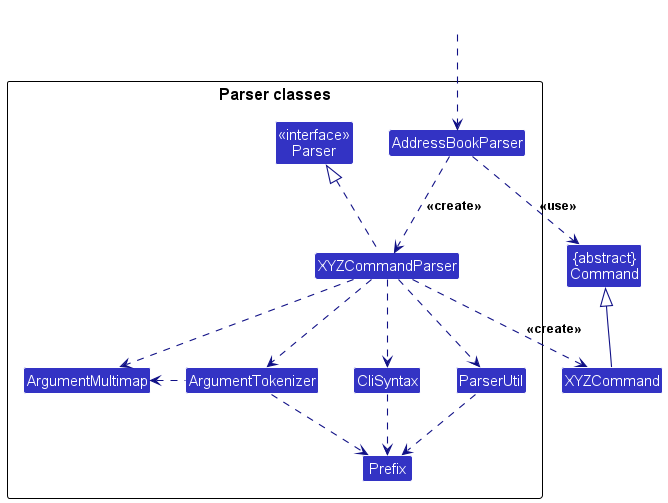
How the parsing works:
- When called upon to parse a user command, the
AddressBookParserclass creates anXYZCommandParser(XYZis a placeholder for the specific command name e.g.,AddCommandParser) which uses the other classes shown above to parse the user command and create aXYZCommandobject (e.g.,AddCommand) which theAddressBookParserreturns back as aCommandobject. - All
XYZCommandParserclasses (e.g.,AddCommandParser,DeleteCommandParser, …) inherit from theParserinterface so that they can be treated similarly where possible e.g, during testing.
Model component
API : Model.java
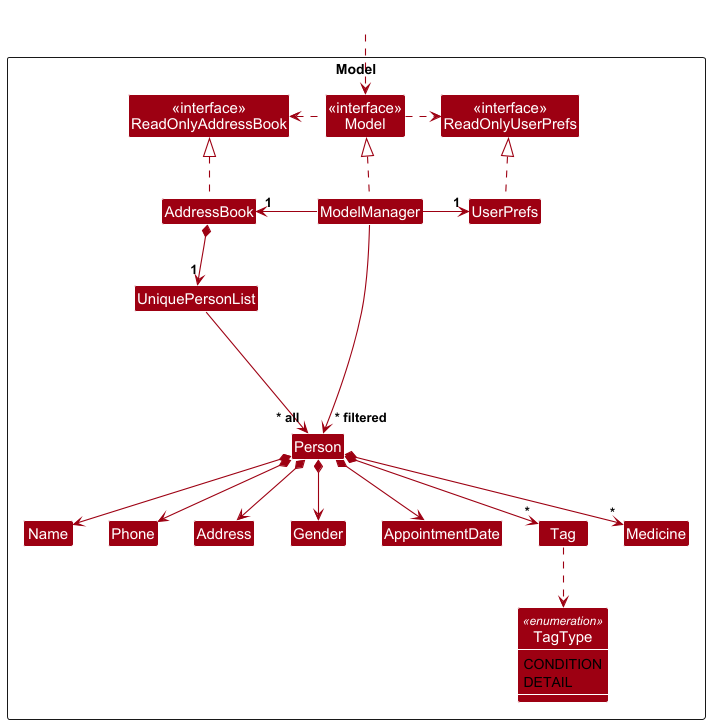
The Model component,
- stores the address book data i.e., all
Personobjects (which are contained in aUniquePersonListobject). - stores the currently ‘selected’
Personobjects (e.g., results of a search query) as a separate filtered list which is exposed to outsiders as an unmodifiableObservableList<Person>that can be ‘observed’ e.g. the UI can be bound to this list so that the UI automatically updates when the data in the list change. - stores a
UserPrefobject that represents the user’s preferences. This is exposed to the outside as aReadOnlyUserPrefobjects. - does not depend on any of the other three components (as the
Modelrepresents data entities of the domain, they should make sense on their own without depending on other components)
Tag list in the AddressBook, which Person references. This allows AddressBook to only require one Tag object per unique tag, instead of each Person needing their own Tag objects.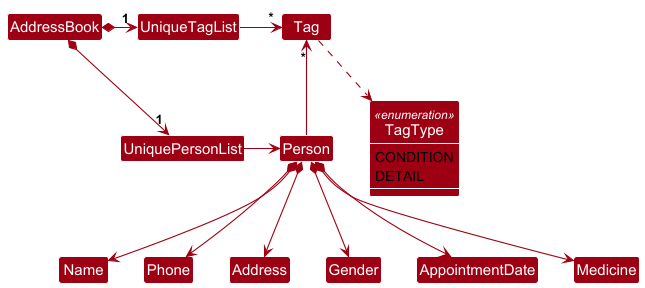
Storage component
API : Storage.java
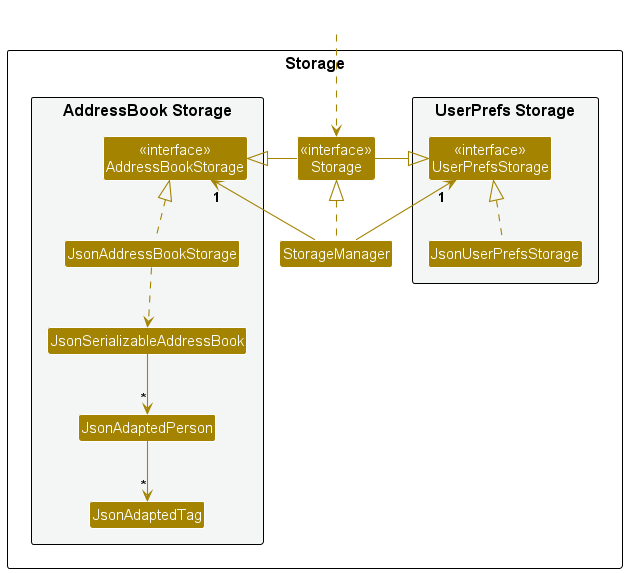
The Storage component,
- can save both address book data and user preference data in JSON format, and read them back into corresponding objects.
- inherits from both
AddressBookStorageandUserPrefStorage, which means it can be treated as either one (if only the functionality of only one is needed). - depends on some classes in the
Modelcomponent (because theStoragecomponent’s job is to save/retrieve objects that belong to theModel)
Common classes
Classes used by multiple components are in the seedu.address.commons package.
Implementation
This section describes some noteworthy details on how certain features are implemented.
Add New Patient
The add feature allows users to register a new elderly patient into SilverCare’s address book, ensuring essential information such as name, phone number, address, gender, appointment date, medicines, and medical notes are captured.
This feature supports home-visit nurses and healthcare workers in efficiently managing patient records.
Overview
-
Command format:
add -n NAME -p PHONE -a ADDRESS -g GENDER [-d APPOINTMENT_DATE] [-c CONDITION]... [-det DETAIL]... [-med MEDICINE] -
Required fields:
-n(Name),-p(Phone),-a(Address),-g(Gender) -
Optional fields:
-d(Appointment Date),-c(Condition Tags),-det(Detail Tags),-med(Medicine) -
Behavior:
- Adds a new patient entry into SilverCare’s records if the command is valid.
- Adding beyond the maximum patient limit (30 patients) is disallowed.
- Duplicate checking is performed based on custom logic.
SilverCare uses a custom duplicate definition suited for elderly care contexts:
- Two patients are treated as duplicates only if both:
- Their names are identical, and
- Their phone numbers are identical.
- Otherwise, they are treated as different individuals, even if:
- They share the same phone number but have different names (e.g., shared phones).
- They share the same name but have different phone numbers.
This design acknowledges that in settings like old age homes or multi-residence households, different patients may share contact numbers or addresses.
Key Classes & Logic
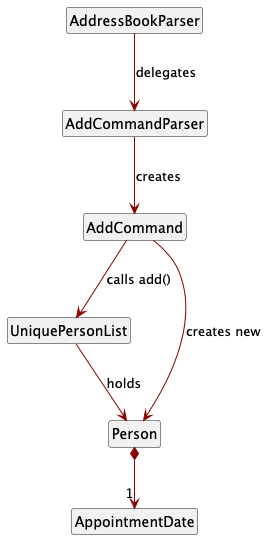
-
AddressBookParser- Recognizes the
addcommand. - Passes arguments to
AddCommandParser.
- Recognizes the
-
AddCommandParser- Tokenizes and parses input arguments based on defined prefixes.
- Validates presence of mandatory fields.
- Parses fields via
ParserUtil, applying constraints (e.g., name length, phone format). - Constructs a
Personobject. - Returns an
AddCommandinitialized with the newPerson.
-
AddCommand- Executes the addition of the new
Personinto the model’s address book. - Enforces duplicate checking and the patient limit constraint.
- Executes the addition of the new
-
UniquePersonList- Adds the
Personif no duplicate is found and capacity permits. - Automatically sorts the list by upcoming appointment dates.
- Adds the
-
Person- Represents an elderly patient record, holding immutable fields such as name, phone, address, gender, appointment date, medicines, conditions, and details.
Design Considerations
-
Name Length Restriction:
- Names must be between 1 to 50 characters.
- This ensures proper UI display without breaking layout across different window sizes.
-
Phone Number Validation:
- Must consist of only numeric digits (0-9).
- Must be between 3 to 15 digits.
- No
+,-, spaces, or special characters are permitted.
Rationale:
- Ensures simplicity in validation and consistency in stored data.
- Avoids ambiguity across international formats if country codes are added separately in the future.
-
Fault Tolerance:
- If mandatory fields are missing, field formats are invalid (e.g., wrong phone number, invalid date), or constraints are violated (e.g., exceeding name length), the
addcommand fails safely. - Clear error messages guide the user to correct the input without crashing the system.
- If mandatory fields are missing, field formats are invalid (e.g., wrong phone number, invalid date), or constraints are violated (e.g., exceeding name length), the
-
Extensibility:
- Adding more optional fields (e.g., emergency contacts) can be done by extending
Person,AddCommandParser, andAddCommandaccordingly.
- Adding more optional fields (e.g., emergency contacts) can be done by extending
-
Consistency:
- All new patients are validated, parsed, and added through a consistent, centralized flow, ensuring system-wide data integrity.
SilverCare is designed to manage elderly patients, not caregivers or next-of-kin.
If the contact number provided belongs to a caregiver or family member instead of the patient, it is recommended to clearly mention this information using the
-det (detail tag) field.This helps users maintain clarity when viewing patient records, but it is not strictly enforced by the system.
Delete Patient or Clear List
The delete and clear commands allow users to remove individual patients or clear the entire address book.
Both operations require confirmation (y to proceed, n to abort) before the action is finalized.
This two-step process helps prevent accidental data loss.
Overview
-
Delete command format:
delete INDEX– Initiates a request to delete the patient at the specified index from the displayed list. -
Clear command format:
clear– Initiates a request to clear all patient records from the address book. -
Confirmation format:
y– Confirms and proceeds with the pending delete or clear operation. -
Abort format:
n– Cancels the pending delete or clear operation.
- The deletion or clearing does not happen immediately upon
deleteorclear. - The system enters a pending state, waiting for explicit user confirmation.
- If the user types a recognized new command (other than
yorn), the pending operation is abandoned automatically. - If the user types an unrecognized input while a pending operation exists, the system prompts the user again for a clear yes (
y) or no (n).
Key Classes & Logic

-
DeleteCommand- Parses the provided index.
- Validates that the index is within bounds and refers to an existing patient.
- Sets the
pendingDeletionfield inModelManager. - Returns a
CommandResultprompting the user to confirm or abort.
-
ClearCommand- Checks if there are any patients to clear.
- Sets the
pendingClearflag inModelManager. - Returns a
CommandResultprompting the user to confirm or abort.
-
ConfirmCommand- If a pending deletion exists, deletes the targeted
Person. - If a pending clear exists, clears the entire address book.
- If both deletion and clear are pending simultaneously (should not normally happen), throws a
CommandException.
- If a pending deletion exists, deletes the targeted
-
AbortCommand- If a pending deletion exists, cancels the pending delete operation.
- If a pending clear exists, cancels the pending clear operation.
- If both are pending simultaneously, throws a
CommandException.
-
ModelManager-
pendingDeletion: holds thePersonobject marked for deletion (ornullif none). -
pendingClear: boolean flag indicating if a clear operation is pending. - Provides methods to set, check, and clear these pending states.
-
-
LogicManager-
checkPendingConfirmation(String commandText)method checks for pending confirmations. - If user input is unrelated to confirmation:
- If input is a recognized command, pending operations are cleared automatically.
- If input is unrecognized, the system throws a
ParseExceptionprompting the user to confirm properly.
-
Design Considerations
-
Fault Tolerance:
Deleting or clearing does not happen immediately, ensuring users cannot accidentally delete important data with a single misclick. -
User Flexibility:
If users change their mind midway and type another valid command, the app cancels the pending operation and executes the new command normally. -
Consistent Confirmation Flow:
Whether deleting one patient or clearing the whole address book, users confirm with a simpley(yes) orn(no). -
Extensibility:
Future operations that require user confirmation can reuse the same pending confirmation mechanism (e.g., batch deletions, bulk updates).
Find patients by name
The find command allows users to search and filter patients by their name. This is particularly useful for home-visit nurses who need to locate patient records quickly during appointments.
Overview
-
Find command format:
find -n KEYWORDS -
KEYWORDScan be a full name or a partial name. -
Multiple keywords can be provided and are space-separated.
-
Example usage:
find -n John/find -n Alice Bob
Behavior
- Matches patients whose names contain all of the specified keywords.
- Matching is case-insensitive and allows for partial matches.
- If no patients match the keywords, an appropriate message is displayed to the user.
- All provided keywords must be found in the same patient's name for a match to occur.
- Example: If the user searches
find -n Alice Bob:- "Alice Tan" matches "Alice" but not "Bob".
- "Bob Lee" matches "Bob" but not "Alice".
- Result: No patient will be displayed because neither patient matches both keywords simultaneously.
Highlighting Matches
- After search results are displayed, the matching portions of the names are highlighted.
- Highlighting is case-insensitive and works even for partial matches.
- Example: Searching for
find -n annwill highlight “Ann” in “Annabelle” and “Johann”.
- Example: Searching for
This improves usability by helping users quickly spot the relevant matches in the results list.
Key Classes & Logic
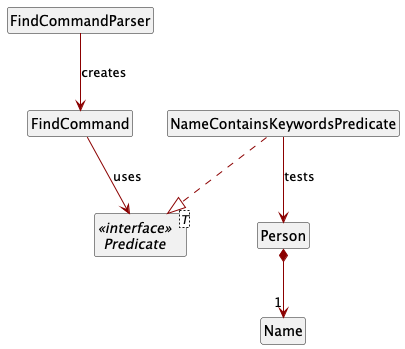
-
FindCommand- Accepts a
Predicate<Person>when constructed. - During execution, calls
model.updateFilteredPersonList(predicate). - Returns a
CommandResultindicating the number of patients found, or a message if none were found.
- Accepts a
-
NameContainsKeywordsPredicate- Implements
Predicate<Person>. - Takes a list of keywords.
- Returns
trueif thePerson’s name contains any of the keywords, ignoring case.
- Implements
-
ModelManager- Handles updating the filtered person list via
updateFilteredPersonList(predicate). - The updated list is then shown in the UI automatically.
- Handles updating the filtered person list via
-
PersonCard- Handles highlighting of matching name parts in the UI after a successful search.
Design Considerations
-
Case-Insensitive Search:
Improves usability by ignoring capitalization differences between user input and stored names. -
Partial Matching:
Allows flexible searches — e.g., entering “Ann” matches “Annabelle” and “Johann”.
This enables nurses to find patients even if they cannot remember the full name or exact spelling, improving efficiency during home visits. -
Independent Patient Matching:
Keywords are checked independently against each patient’s name. There is no cross-patient aggregation of keywords.
This ensures that search results accurately reflect a single patient’s record matching all criteria, avoiding confusion where unrelated patients might otherwise satisfy different parts of the search unintentionally. -
Fault Tolerance:
No crashes occur if there are no matching results. An informative message is displayed. -
Extensibility:
ThePredicate<Person>architecture makes it easy to extend to other fields (e.g., conditions, addresses) without changing the core logic ofFindCommand.
Example
| User Input | Behavior |
|---|---|
find -n John |
Displays all patients whose names contain the word “John” (case-insensitive). |
find -n joHN |
Displays the same results as find -n John — the search is case-insensitive. |
find -n |
Error — name keyword cannot be empty. |
find -n John Doe |
Displays all patients whose names contain both “John” and “Doe” in that order. |
find -n Annette John |
Displays patients whose names contain both “Annette” and “John”. |
Find Patients by Appointment Date
This find feature allows users to search for patients who have a specific appointment date scheduled.
This functionality is helpful when nurses want to quickly check who they are scheduled to visit on a particular day.
Overview
-
Command format:
find -d APPOINTMENT_DATE - Filters patients whose appointment date exactly matches the provided date input.
- Supports both date-only format (e.g.,
yyyy-MM-dd) and full datetime format (e.g.,yyyy-MM-dd HH:mm).
Behavior
- Users must provide a valid date format. Otherwise, parsing fails and an error is shown.
- Matching is exact — the appointment must match the date input provided.
- If the input includes only the date (e.g.,
2025-04-10), only appointments on that date (ignoring time) are matched. - If the input includes date and time (e.g.,
2025-04-10 14:30), the match is stricter, including both date and time.
- If the input includes only the date (e.g.,
- Partial matches (e.g., just matching the year or month) are not supported.
Key Classes & Logic
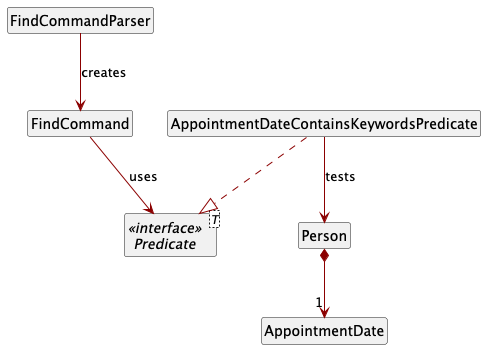
-
FindCommandParser- Detects the
-dprefix in user input. - Parses the appointment date string provided.
- Creates a
FindCommandwith anAppointmentDatePredicate. - Throws a
ParseExceptionif the date format is invalid.
- Detects the
-
AppointmentDateContainsKeywordsPredicate- Implements
Predicate<Person>. - Checks if a patient’s appointment date matches the parsed input date.
- Supports parsing both:
-
Date-only (
yyyy-MM-dd) — matches any appointment with that date. -
Datetime (
yyyy-MM-dd HH:mm) — matches the exact appointment datetime.
-
Date-only (
- Implements
-
FindCommand- Accepts the
AppointmentDatePredicateduring construction. - During execution, calls
model.updateFilteredPersonList(predicate), updating the view to show only matching patients.
- Accepts the
-
AppointmentDate- Represents a patient’s appointment date field.
- Ensures that date strings stored in the system are valid and consistent.
-
PersonCard- Handles highlighting of matching appointment dates in the UI after a successful search.
Design Considerations
-
Strict Date Parsing:
The command enforces strict formatting to prevent confusion caused by ambiguous or partial dates. -
Two-level Matching Flexibility:
- If users input only the date (no time), matches are based on the date alone.
- If users input full date and time, matches are based on both.
This balances ease of use (for day-based searches) with precision (for exact-time searches).
-
Fault Tolerance:
When invalid date formats are entered, the system throws aParseExceptionwith a clear message, guiding users to correct their input without crashing the app. -
Extensibility:
ThePredicate<Person>structure means the logic for date matching is fully encapsulated. Future enhancements (e.g., range searches, week-based searches) can be added by introducing new predicates without modifying core classes likeFindCommand. -
Highlighting Matches:
Matching appointment dates are highlighted in the UI after search results are shown.
This improves visibility and quickly draws attention to relevant fields.
Example
| User Input | Behavior |
|---|---|
find -d 2025-04-10 |
Displays all patients with appointments on 10 April 2025, regardless of time. |
find -d 2025-04-10 14:30 |
Displays only patients with an appointment exactly on 10 April 2025 at 2:30 PM. |
find -d 2025-4-10 |
Error — invalid format. Requires leading zeros (e.g., 2025-04-10). |
Find Upcoming Appointments
The upcoming feature under the find command allows users to filter and display only those persons who have future appointments scheduled. This functionality is useful for quickly identifying clients with pending appointments.
Overview
- Command format:
find upcoming - Filters out persons whose appointment dates are before or equal to the current date and time.
- Supports both date-only and full datetime formats (e.g.,
2025-04-01or2025-04-01 14:30).
Key Classes & Logic
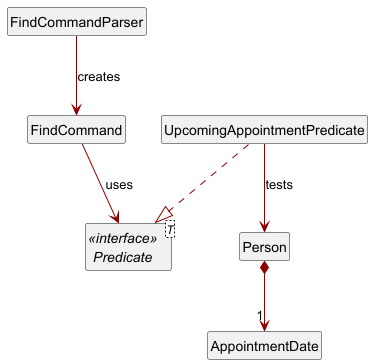
-
FindCommandParser- Detects if the user input is exactly
"upcoming"(case-insensitive). - If matched, it returns a
FindCommandinitialized with anUpcomingAppointmentPredicate. - This diverges from the usual
-n(name) or-d(appointment date) prefixes.
- Detects if the user input is exactly
-
UpcomingAppointmentPredicate- Implements
Predicate<Person>. - Extracts the
appointmentDatefrom eachPerson. - Attempts to parse the string as either:
- a full datetime using format
yyyy-MM-dd HH:mm, or - a date-only format
yyyy-MM-dd(defaults to00:00for comparison).
- a full datetime using format
- Compares the parsed result to
LocalDateTime.now()and returnstrueonly if the appointment is strictly after the current moment.
- Implements
-
AppointmentDate- Normalizes and validates user-inputted date strings.
- Accepts and validates both formats using regex and Java’s
DateTimeFormatter. - Helps maintain consistent formatting throughout the system.
-
FindCommand- When executed, it passes the predicate to the model’s
updateFilteredPersonList(), causing the filtered list to update with only persons matching the predicate.
- When executed, it passes the predicate to the model’s
Each
find command is designed to accept only one search type at a time.- You must choose either:
- Find by
-n(Name), - Find by
-d(Appointment Date), or - Find
upcomingappointments.
- Find by
- Combining multiple types in one command (e.g.,
find -n John -d 2025-12-12) is not supported and will result in an error displayed to users.
Design Considerations
-
Fault Tolerance:
Parsing errors during predicate evaluation (such as invalid appointment dates) result in a safefalsereturn.
This ensures the app remains stable and does not crash even if invalid data is encountered during a search. -
Extensibility:
The predicate-based design allows easy addition of new search filters (e.g., finding past appointments, filtering by appointment week) without modifying existing logic.
Developers can simply introduce newPredicate<Person>classes to extend functionality. -
Single Responsibility Principle (SRP):
Each class involved in the find-upcoming feature has a clear and separate responsibility:-
FindCommandParserhandles parsing the user’s input. -
UpcomingAppointmentPredicatehandles checking appointment timing logic. -
AppointmentDatehandles formatting and validation of date strings.
This separation improves maintainability and readability of the codebase.
-
Edit patient details
The edit feature allows users to modify the details of an existing patient in SilverCare’s address book.
Overview
-
Edit command format:
edit INDEX [-n NAME] [-p PHONE] [-a ADDRESS] [-g GENDER] [-d APPOINTMENT_DATE] [-c CONDITION]... [-det DETAIL]... [-med MEDICINE] -
Required fields:
INDEX(the index of the patient to edit, from the displayed list) -
Optional fields: Any combination of
-n,-p,-a,-g,-d,-c,-det,-med -
Example usage:
edit 1 -n John Doe -p 91234567 -a 123 Clementi Ave 3 -g Male edit 2 -d 2025-05-01 edit 3 -c High BP -c Diabetes -det wheelchair-bound -med Panadol
Behavior
- The
editcommand allows selective field updates — only the fields provided are modified. - Fields not specified remain unchanged.
- Editing patient information that would cause duplication (e.g., creating two patients with identical name and phone number) is disallowed.
- After editing, the patient list is re-sorted automatically by upcoming appointment dates, if the appointment date was changed.
📌 Important:
If a patient’s appointment date is edited, the patient list dynamically reorders itself to maintain chronological sorting of upcoming appointments.
This ensures that nurses always view patients in order of scheduled visits.
-
If no fields are provided to edit, the system shows an error:
At least one field to edit must be provided. -
If the provided index is invalid (e.g., out of bounds), an appropriate error message is shown.
Key Classes & Logic
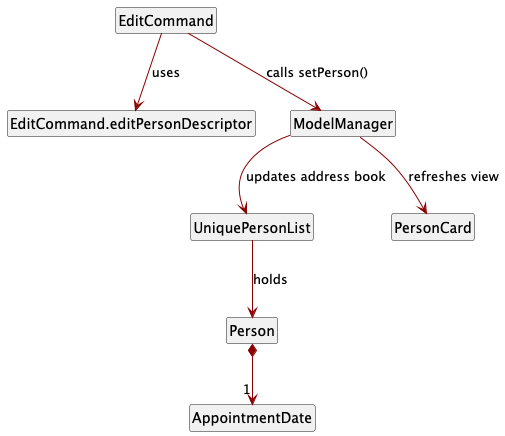
-
EditCommand- Receives the index and an
EditPersonDescriptorcontaining the new field values. - Retrieves the corresponding
Personfrom the current filtered list. - Creates a new
Personby combining the existing fields and the edited ones. - Validates against duplication rules.
- Updates the model with the edited person.
- Refreshes the filtered list with
PREDICATE_SHOW_ALL_PERSONS. -
If appointment date was modified:
The person list is automatically re-sorted by upcoming appointment dates.
- Receives the index and an
-
EditCommand.editPersonDescriptor- A helper class that stores which fields are edited.
- Supports checking whether any field was actually modified.
- Makes defensive copies of tag sets (
conditionTags,detailTags).
-
ModelManager-
setPerson(Person target, Person editedPerson)updates the address book entry. -
updateFilteredPersonList(PREDICATE_SHOW_ALL_PERSONS)refreshes the patient list. - The person list is automatically sorted by appointment date after any addition or edit that modifies appointment dates.
-
-
UniquePersonList- Handles person uniqueness checks when replacing a person.
- Ensures that two persons with the same identifying information cannot coexist.
-
PersonCard- Displays updated patient information in the GUI.
- Highlights search keyword matches for names and appointment dates if a find operation is active.
Design Considerations
-
Minimal disruption:
Only the specified fields are updated; all other information remains unchanged, reducing the risk of unintentional data loss. -
Fault tolerance:
- Prevents edits that would result in duplicate patients.
- Provides clear error messages when index is invalid or no fields are specified.
- Ensures system remains stable and data remains consistent even if partial input is provided.
-
Automatic sorting:
Whenever appointment dates are edited, the patient list is re-sorted automatically without requiring manual intervention.
This guarantees that the nurse’s view remains organized by upcoming visits. -
Consistency with add flow:
Editing fields uses the same validation rules as adding a patient (e.g., name format, phone number restrictions), ensuring consistent data quality. -
Extensibility:
Future fields (e.g., adding emergency contacts, allergies) can be incorporated easily into the edit mechanism by expandingEditPersonDescriptorand adjusting parsing logic.
List Patients
The list feature allows users to reset the patient view to display all currently stored patients.
This is particularly useful after performing a search, filter, or any operation that narrows down the patient list.
Overview
-
Command format:
list -
Behavior:
- Displays all patients currently stored in SilverCare.
- If the list was previously filtered (e.g., after a
findcommand), the view resets to show the full list. - The patients are shown sorted by appointment date (earliest first), as per the address book’s standard ordering.
- No parameters are needed — simply typing
listis sufficient.
Key Classes & Logic
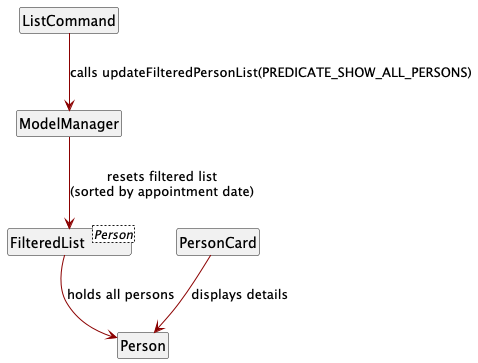
-
ListCommand- Implements the
Commandinterface. - When executed, it calls
model.updateFilteredPersonList(PREDICATE_SHOW_ALL_PERSONS). - This resets the filtered list to include all persons from the address book.
- Returns a
CommandResultwith a simple success message (“Listed all persons”).
- Implements the
-
ModelManager- Holds the
updateFilteredPersonList()method. - When
PREDICATE_SHOW_ALL_PERSONSis passed in, it resets the internal filtered list to include all persons.
- Holds the
-
PersonCard- The UI automatically updates to display all persons.
- Patients are shown with their respective details (name, phone, address, appointment date, conditions, etc.).
- Patients remain sorted by appointment date after listing — because the internal list is always maintained sorted whenever patients are added or edited.
Design Considerations
-
Simplicity:
No arguments are required — a simplelistcommand brings back the full patient list immediately. -
Fault Tolerance:
No errors occur iflistis used when already viewing all patients — the operation is harmless and simply reaffirms the full list. -
Consistency:
Patients are consistently displayed sorted by upcoming appointment date to help nurses easily prioritize visits. -
Extensibility:
Future versions could extend thelistcommand with optional flags (e.g.,list archived) to display archived patients separately without affecting the current structure.
Documentation, logging, testing, configuration, dev-ops
Appendix: Requirements
Product scope
Target user profile:
- Nurses who do home visits for elderly patients
- Needs to manage a significant number of contacts
- Is reasonably comfortable using CLI-based apps
Value proposition: The app will help nurses caring for elderly patients manage contact details of their home-visit patients within one platform.
Note: At present, SilverCare is designed to manage patient contacts only. It does not support storing information for family members, guardians, or emergency contacts. This decision was made intentionally to keep the app focused and avoid ambiguity during patient record management.
User stories
Priorities: High (must have) - * * *, Medium (nice to have) - * *, Low (unlikely to have) - *
| Priority | As a … | I want to … | So that I can… |
|---|---|---|---|
* * * |
user | see usage instructions | refer to instructions when I forget how to use the app |
* * * |
new user | have a quick-start guide | learn how to use the app with minimal confusion from the beginning |
* * * |
user | view a help window while using the app | access reminders of the commands |
* * * |
home-visit nurse | add a new patient’s contact details | keep track of their information and reach out when needed |
* * * |
home-vist nurse | add a new patient’s full information, including medical details | keep track of the patients I visit |
* * * |
home-visit nurse managing multiple patients | update an existing patient’s information | always have accurate and up-to-date records |
* * * |
home-visit nurse | add appointment dates for patients | know when each patient is scheduled for a visit |
* * * |
home-visit nurse | add custom notes or details about a patient | remember important context like accessibility needs |
* * * |
home-visit nurse | store multiple conditions for a patient | keep track of their medical history |
* * * |
home-visit nurse | add a list of prescribed medications | log the patient’s current treatment |
* * * |
user | delete a patient | clean up records I no longer need |
* * * |
user | see a confirmation message before deleting a patient record | avoid accidentally removing important data |
* * * |
home-visit nurse during visits | search for a patient by name | find important information quickly during a visit |
* * * |
user | search for a patients using partial names | find a patient even if I don’t remember their full name |
* * * |
home-visit nurse | search for patients by appointment date | check who I need to visit on a specific day |
* * * |
home-visit nurse | view all upcoming appointments | plan and prepare for upcoming visits |
* * * |
user | have search results highlight matching text | quickly identify relevant records |
* * * |
user | list all patients | get a full overview of who is currently in the system |
* * * |
user | clear all my patient records | reset and start with a clean slate |
* * * |
user | see a confirmation message before clearing all patient records | avoid accidentally removing important data |
* * |
home-visit nurse with many patients | sort my patient list by name | locate a person easily |
* * |
user | search for patients by phone number | retrieve contact details even if I only have a number available |
* * |
user | see a warning when I exceed the patient limit | know that the app has reached capacity |
* * |
user | get error messages that include example usage | quickly learn how to correct errors I made |
* * |
security-conscious user | lock or hide sensitive patient contact details | prevent unauthorized individuals from accessing them |
* * |
user | toggle between light and dark mode | choose a display that’s comfortable for my eyes |
* |
busy nurse | categorize patients based on their conditions or priority level | focus on urgent cases first |
* |
home-visit nurse with many patients | filter my patient list by location | optimize my travel schedule for house visits |
Use cases
(For all use cases below, the System is the SilverCare and the Actor is the nurse, unless specified otherwise)
Use Case 1: Add a new patient
Goal: Add a new patient’s contact and medical information.
MSS:
- Nurse provides the required patient information: name, phone number, address, and gender.
- Nurse may also provide optional information: appointment date, medical condition, medicine issued and additional notes.
- System validates the data provided.
- System checks whether a patient with same identifying details already exists.
- System creates a new patient record and assigns it a unique ID.
- System confirms addition and displays the new patient in the patient list.
- Use case ends.
Extensions:
- 2a. System detects invalid or incomplete entered data.
- 2a1. System requests for the correct data.
- 2a2. Nurse enters new data
- Steps 2a1-2a2 are repeated until the data entered are correct.
- Use case resumes from step 3.
- 3a. System detects duplicate patient
- 3a1. System informs Nurse that the patient already exists.
- 3a2. System cancels the add request.
- Use case ends.
Use case 2: Delete an existing patient
Goal: Delete an existing patient’s contact and medical information.
MSS
- Nurse requests to delete an existing patient contact.
- Nurse provides the patient’s index in list.
- System validates the provided patient index.
- If valid, System prompts Nurse to confirm the deletion.
- Nurse confirms the deletion.
- System deletes the corresponding patient record.
- System informs Nurse that the deletion is successful.
- Use case ends.
Extensions
- 3a. System detects invalid patient index.
- 3a1. System requests for the correct data.
- 3a2. Nurse enters new data
- Steps 3a1-3a2 are repeated until the data entered are correct.
- Use case resumes from step 4.
- 3b. System does not find a patient with the provided index.
- 3b1. System informs the Nurse that no matching patient exists.
- 3b2. System requests a different patient index.
- 3b3. Nurse provides a new patient index.
- Steps 3b1–3b3 are repeated until a matching patient is found.
- Use case resumes from step 4.
- 4a. Nurse cancels deletion.
- Nurse declines the confirmation prompt.
- System informs Nurse that the deletion has been cancelled.
- Use case ends.
- 4b. Nurse types unrecognised, non-command input for confirmation of delete.
- 4b1. System re-prompts Nurse to confirm deletion (expects yes or no).
- 4b2. Steps 4 continues until a valid response is provided.
- Use case resumes from 5 (if yes) or 4a (if no).
- 4c. Nurse requests for another command.
- 4c1. System assumes the deletion has been abandoned.
- 4c2. System cancels the deletion request without deleting any patient.
- Use case ends.
Use case 3: Find a patient by name
Goal: Search for a patient’s record by their name.
MSS
- Nurse requests to search for a patient by name.
- Nurse provides a name to search for.
- System validates the provided name (e.g., non-empty, valid characters).
- System searches for patient records containing the name (case-insensitive).
- System displays a list of matching patient records.
- Use case ends.
Extensions
- 3a. Nurse provides empty name query.
- 3a1. System informs the Nurse that the name cannot be empty.
- 3a2. System requests a valid name.
- 3a3. Nurse provides a new search name.
- Steps 3a1–3a3 are repeated until a valid name is entered.
- Use case resumes from step 4.
- 4a. No matching patient records found.
- 4a1. System informs the Nurse that no matching records were found.
- 4a2. System requests a new search input.
- 4a3. Nurse provides a new search name.
- Steps 4a1–4a3 are repeated until a match is found or the search is cancelled.
- Use case resumes from step 4 or ends if cancelled.
Use case 4: Find a patient by appointment date
Goal: Search for a patient’s record by appointment date.
MSS
- Nurse requests to search for a patient by appointment date.
- Nurse provides a date to search for.
- System validates the provided date format.
- System searches for patient records with matching appointment dates.
- System displays a list of matching patient records.
- Use case ends.
Extensions
- 3a. Nurse provides wrongly formatted date query.
- 3a1. System informs the Nurse that the date format is wrong.
- 3a2. System requests a correctly formatted date input.
- 3a3. Nurse provides a new date.
- Steps 3a1–3a3 are repeated until a valid date is entered.
- Use case resumes from step 4.
- 3b. Nurse provides invalid date query.
- 3b1. System informs the Nurse that the date entered does not exist.
- 3b2. System requests a valid date input.
- 3b3. Nurse provides a new date.
- Steps 3b1–3b3 are repeated until a valid date is entered.
- Use case resumes from step 4.
- 4a. No matching patient records found.
- 4a1. System informs the Nurse that no matching records were found.
- Use case ends.
Use case 5: Find upcoming appointments
Goal: Retrieve all patient records with appointment dates that are scheduled after the current system time.
MSS
- Nurse requests to view upcoming appointments.
- System retrieves the current date and time.
- System searches for all patients whose appointment dates are scheduled after the current system time.
- System displays a list of matching patient records.
- Use case ends.
Extensions
- 3a. No upcoming appointments found.
- 3a1. System informs Nurse that there are no upcoming appointments.
- Use case ends.
Use case 6: Edit a patient record
Goal: Modify an existing patient’s contact or medical information.
MSS
- Nurse requests to edit a patient record
- Nurse provides the patient index and specifies one or more fields to update (e.g., name, phone, address, gender, etc.).
- System validates the patient index and each field to be updated.
- System updates the patient record with the new information.
- System confirms the successful update.
- Use case ends.
Extensions
- 3a. Invalid patient index provided
- 3a1. System informs Nurse that the command is invalid or patient index is out of range.
- 3a2. System requests a valid patient index.
- 3a3. Nurse provides a new index.
- Steps 3a1–3a3 repeat until a valid patient index is provided.
- Use case resumes from step 3.
- 3b. Invalid input for one or more fields
- 3b1. System informs the Nurse that the command is invalid.
- 3b2. System requests corrected values for the invalid fields.
- 3b3. Nurse provides corrected input.
- Steps 3b1–3b3 repeat until all inputs are valid.
- Use case resumes from step 4.
- 3c. No fields updated
- 3c1. System informs Nurse that at least one field has to be edited.
- 3a2. System requests at least one field to be updated.
- 3a3. Nurse provides a new valid input.
- Steps 3a1–3a3 repeat until a valid input is provided.
- Use case resumes from step 3.
Use case 7: Clear all patient records
Goal: Remove all existing patient records from the system.
MSS
- Nurse requests to clear all patient records.
- System prompts Nurse for confirmation before proceeding.
- Nurse confirms the action.
- System deletes all patient records from the system.
- System informs Nurse that the address book has been cleared.
- Use case ends.
Extensions
- 3a. Nurse cancels the clear request
- 3a1. Nurse declines the confirmation prompt.
- 3a2. System informs Nurse that the clear action has been cancelled.
- Use case ends.
- 4a. No records to clear
- 4a1. System detects that there are no patient records to delete.
- 4a2. System informs the Nurse that the address book is already empty.
- Use case ends.
Use case 8: List all patients
Goal: View all active patient records.
MSS
- Nurse requests to view all patient records.
- System retrieves all stored patient records.
- System displays the list of patients.
- Use case ends.
Extensions
- 2a. No patients found in the system.
- 2a1. System informs the Nurse that there are no patient records available.
- Use case ends.
Use case 9: Toggle application theme
Goal: Switch the application’s appearance between light and dark mode.
MSS
- Nurse toggles the application theme.
- System determines the current theme (light or dark).
- System switches to the opposite theme.
- System applies the new theme across the user interface.
- Use case ends.
Use case 10: Display help information
Goal: Provide guidance to Nurse on how to use the system’s commands and features.
MSS
- Nurse requests to view help information.
- System opens a help window.
- System displays example commands and usage instructions.
- System provides a hyperlink to view the full user guide.
- Use case ends.
Use case 11: Exit the application
Goal: Safely terminate the SilverCare application.
MSS
- Nurse requests to exit the application.
- System saves any unsaved data.
- System terminates the application.
- Use case ends.
Non-Functional Requirements
- Should work on any mainstream OS as long as it has Java
17or above installed. - The system should efficiently handle at least 30 patient records, with all operations (e.g., search, add, delete) completing within 1 second on typical hardware.
- A user with above average typing speed for regular English text (i.e. not code, not system admin commands) should be able to accomplish most of the tasks faster using commands than using the mouse.
- The system should be able to search patient records within 2 seconds.
- The interface should be accessible and navigable by nurses with basic training within 1 hour. The app should allow viewing patient details even without an internet connection.
- The system’s user interface (UI) and documentation must be clear, comprehensive, and understandable for nurses and healthcare professionals without advanced IT skills.
- The app is not required to connect to the hospital’s database.
- The application must function fully offline, with all patient details accessible without an internet connection.
- The app is not required to handle phone calls to the contact numbers of entries.
- The application should gracefully handle invalid inputs and unexpected errors, providing clear error messages without crashing.
Glossary
- Mainstream OS: Windows, Linux, Unix, MacOS
- User: A home-visit nurse who interacts with the SilverCare system to manage patient information.
- New User: A first-time user of the system who may require guidance on how to use the application.
- Home-Visit Nurse: A nurse who provides medical care to elderly patients in their homes, rather than at a hospital or clinic.
- Patient Management: The ability to store, update, and retrieve patient details such as name, contact information, and medical history.
- Contact Details: A patient’s phone number, address, and any other means of communication stored within the system.
- Private contact detail: A contact detail that is not meant to be shared with others
- Patient Record: A stored entry containing a patient’s personal details, contact information, and relevant medical notes.
- Patient Index: A system-generated number assigned to each patient record to ensure easy identification and management.
Appendix: Instructions for manual testing
Given below are instructions to test the app manually.
Launch and shutdown
-
Initial Launch
- Download the JAR file and copy it into an empty folder.
- Open your Command Prompt (Windows) or Terminal (Mac/Linux) and navigate to the folder with the JAR file.
cd path/to/file - Run the following command:
java -jar silvercare.jar - Expected: The GUI appears with a set of sample patient records.
-
Shutdown
- Close the application using the exit command:
exit - Expected: The application closes successfully.
- Close the application using the exit command:
Managing Patients
Adding a Patient
-
Prerequisites:
- Adding a patient must be done with all compulsory fields (name, phone, address, gender).
- Command format for each field should follow as stated in User Guide
-
Test case 1 (With compulsory fields):
add -n John Doe -p 91234567 -a 123 Clementi Ave 34 -g MaleExpected: John Doe appears in the patient list with correct details.
-
Test case 2 (With optional fields):
add -n Johnny -p 92345678 -a 123 Clementi Ave 34 -g Male -d 2025-04-05 -c High BP -det lives alone -med PanadolExpected: Johnny appears in the patient list with correct details.
Editing a Patient
-
Prerequisites:
- Index given must be positive (1,2,3…) and not out of range of list of patients.
- Command format for each field should follow as stated in User Guide
-
Test case 1 (Edits name of patient at index 1):
list edit 1 -n BobbyExpected: The name of the first patient index updates correctly to Bobby.
-
Test case 2 (Edits name and phone number of patient at index 1):
list edit 1 -n Bobby -p 91283131Expected: The name and phone number of the first patient index updates correctly to Bobby and 91283131 respectively.
-
Test case 3 (Edits condition of patient at index 2 to the 3 new conditions stated):
list edit 2 -c Dementia -c Asthma -c DiabeticExpected: The condition of the second patient index updates correctly to the three stated as above.
-
Test case 4 (Invalid Command):
edit hiExpected: Error message pops up due to incorrect formatting.
Deleting a Patient
-
Prerequisites:
- Index given must be positive (1,2,3…) and not out of range of list of patients.
-
Test case 1 (Successfully deletes patient at index 1):
list delete 1 yExpected: A confirmation prompt pops up and successfully deletes patient 1 after inputting [y].
-
Test case 2 (Abort deletion of patient at index 1):
list delete 1 nExpected: A confirmation prompt pops up and aborts deleting patient 1 after inputting [n].
-
Test case 3 (Invalid command):
list delete HIExpected: Error message pops up due to incorrect formatting.
Searching and Filtering
-
Prerequisites:
- Index given must be positive (1,2,3…) and not out of range of list of patients.
- Command format should follow as stated in User Guide
-
Test case 1 (Find by name):
list find -n JohnExpected: Only matching patients containing name “John” are shown.
-
Test case 2 (Find by date):
list find -d 2025-04-12Expected: Only matching patients with appointment date of “2025-04-12” are shown.
-
Test case 3 (Find upcoming appointments):
list find upcomingExpected: Only matching patients with appointment dates after current system timing are shown.
Data Handling
Saving Data
- Expected: Changes persist after restarting the application.
Handling Missing/Corrupted Files
- To simulate: Delete or corrupt the data file before launching the app.
- Expected: The application should recover gracefully and provide an error message or reset data appropriately.
Edge Cases
Invalid Inputs:
- Enter an invalid phone number (
-p abcd1234). - Delete a non-existent patient.
Expected: Proper error messages.
Testers should verify that expected results match actual outcomes and report any inconsistencies as bugs.
Ensure that all covered features work as intended while considering possible edge cases.
For full command details, refer to the User Guide.
Appendix: Effort
The development of SilverCare involved adapting and extending the AddressBook-Level3 codebase to better suit the needs of home-visit nurses. The team focused on improving usability, expanding patient-related functionality, and ensuring the application remained robust and maintainable.
Key development efforts included:
-
Enhancing core commands (
add,edit,find, etc.) to support patient-specific data such as appointment dates, conditions, and medication -
Refactoring the model and storage structure to accommodate new fields and tag types
-
Updating and writing unit tests to ensure system correctness after changes
-
Streamlining the user interface and user guide to better support a non-technical audience
The team maintained regular weekly check-ins to coordinate tasks, discuss challenges, and review progress. All members contributed equally across design, implementation, and testing phases, ensuring a balanced and collaborative workflow.
Appendix: Planned Enhancements
Team size: 5
1. Disallow adding past appointment dates
Current Limitation: The system currently allows users to add appointment dates that have already passed.
Planned Enhancement: Restrict users from entering past dates for new or edited appointments.
Sample Output:
Appointment date must be today or later.
2. Make the medicine field more structured and repeatable
Current Limitation: The medicine field is currently a single long string, which accepts comma-separated medicine names but offers no structure or repeatability. Users cannot add medicine entries separately or include details like dosage and frequency.
Planned Enhancement:
Allow the -med field to be repeatable and support structured input for each entry (e.g. name, dosage, frequency).
This makes it easier to store, update, and display individual medication records.
Sample Input (future):
-med Paracetamol (500mg, twice a day) -med Omeprazole (20mg, once daily)
3. Improve input validation and matching for name-based search
Current Limitation:
The find -n command accepts any non-empty input and defaults to “no patients found.” and has a strict matching format.
Planned Enhancement:
- Detect clearly invalid inputs (e.g. empty, all-symbol, extremely short) and display a more meaningful error message.
- Allow less strict matching such as correct/partial name match in wrong order and partial matches in correct order.
Sample Output:
Search term is invalid. Please enter a proper name.-
find -n Doe John,find -n Do Jo,find -n Jo Doandfind -n John Doeall returning patient John Doe.
4. Allow appointment date to be cleared using the edit command
Current Limitation:
Unlike -c and -det, providing an empty -d does not clear an existing appointment date.
Planned Enhancement:
Support clearing the appointment date by accepting -d with no argument during edit.
Sample Input: edit 1 -d
5. Add find-and-replace functionality for editing tags
Current Limitation: Editing a single condition or detail tag requires re-entering all tags, as the current logic replaces the entire existing list.
Planned Enhancement:
Introduce a find-and-replace syntax to update a specific tag in-place.
Sample Input:
edit 2 -c Migraine->Chronic Migraine -det Lives Alone->Requires Assistance
6. Warn users about overlapping appointments
Current Limitation: There is no indication if multiple appointments are scheduled for the same date and time.
Planned Enhancement: Detect and warn the user when a newly entered appointment overlaps with an existing one for the same patient.
Sample Output:
Warning: This appointment overlaps with another on 2025-07-20 at 14:00.
7. Fix highlight issue in multi-word name searches
Current Limitation:
When using find -n with multi-word input (e.g. John Lim), matches are returned but highlighted text only works for single words.
Planned Enhancement: Improve result rendering to highlight all matched words in multi-keyword searches.
8. Enable multi-name search to match across multiple patients
Current Limitation:
find -n Bob Amy only returns matches where both keywords are found in the same patient name. It does not return separate matches for “Bob” and “Amy.”
Planned Enhancement: Allow find -n to return results for any of the keywords (logical OR), not just matches containing all of them.
9. Improve robustness of flag handling
Current Limitation:
edit 1 -med panadol -cough syrup causes medicine field to be edited to panadol while conditions field to ough syrup due to the -c flag present.
Planned Enhancement: Better flag handling to ensure the intended field is updated as expected when the input contains other flags.